Characteristics and Paleoenvironment of High-Quality Shale in the Triassic Yanchang Formation, Southern Margin of the Ordos Basin
Abstract
:1. Introduction
2. Geological Background
3. Samples and Analytical Methods
4. Results and Discussion
4.1. Quality Shale Characteristic
4.1.1. Outcrop Profile Performance
Nijiahe Outcrop
Tangnihe Outcrop
Shanshuihe Outcrop
4.1.2. The Core and the Microscopic Chip Performance
4.1.3. Geophysical Response Characteristics
Seismic Response Characteristics
Logging Response Characteristics
4.1.4. Geochemical Characteristics
4.2. Analysis of Sedimentary Paleoenvironment of High-Quality Shale
4.2.1. Redox Condition
4.2.2. Paleoclimate and Paleosalinity
4.2.3. Paleowater Depth
5. Conclusions
- (1).
- The high-quality shale at the bottom of the Chang 7 member of the Yanchang Formation includes black shale, dark massive mudrock and silty mudstone. The organic matter in black shale is mainly interbedded or stratified, the organic matter in dark massive mudstone is dispersed, and the content of organic matter in silty mudstone is low. The shale shows high gamma, high acoustic time difference, high resistance well-logging phase and strong-amplitude parallel–subparallel seismic phase characteristics.
- (2).
- The sedimentary thickness of this set of high-quality shales gradually increases from the edge of the basin (5–10 m) to the center of the basin, among which the black shale of the Jiyuan–Huachi–Yijun line has the largest thickness (more than 30 m). This set of high-quality shales was mainly formed under a warm and humid paleoclimate, in water depths of 60–120 m, and in an anaerobic reducing and continental freshwater paleoenvironment.
Author Contributions
Funding
Data Availability Statement
Conflicts of Interest
Nomenclatures
| h | Paleowater depth (m); |
| NCo | Abundance of Co in normal lake sediments (20 μg/g); |
| NLa | Average abundance of La in terrigenous clastic rocks (38.99 μg/g); |
| SCo | Abundance of Co in sample (μg/g); |
| SLa | Abundance of La in sample (μg/g); |
| t | Contribution value of source cobalt (Co) to the sample; |
| TCo | Abundance of Co in terrigenous clastic rocks (4.68 μg/g); |
| Vs | Velocity of sediment (mm/a); |
| V0 | Normal velocity of the lake (0.2~0.4 mm/a). |
References
- Brendow, K. Global oil shale issues and perspectives. Oil Shale 2003, 20, 81–92. [Google Scholar] [CrossRef]
- Dynij, R. Geology and resources of some world oil shale deposits. Oil Shale 2003, 20, 193–252. [Google Scholar] [CrossRef]
- Wang, S.; Yao, X.; Feng, Q.; Farzam, J.; Yang, Y.; Xue, Q.; Li, X. Molecular insights into carbon dioxide enhanced multi-component shale gas recovery and its sequestration in realistic kerogen. Chem. Eng. J. 2021, 425, 130292. [Google Scholar] [CrossRef]
- Zou, C.; Yang, Z.; Cui, J.; Zhu, R.; Hou, L. Formation mechanism, geological characteristics and development strategy of nonmarine shale oil in China. Pet. Explor. Dev. 2013, 40, 14–25. [Google Scholar] [CrossRef]
- Ibrahim, M.A.; Saleh, T.A. Partially aminated acrylic acid grafted activated carbon as inexpensive shale hydration inhibitor. Carbohydr. Res. 2020, 491, 107960. [Google Scholar] [CrossRef]
- Ibrahim, M.A.; Saleh, T.A. Synthesis of efficient stable dendrimer-modified carbon for cleaner drilling shale inhibition. J. Environ. Chem. Eng. 2021, 9, 104792. [Google Scholar] [CrossRef]
- Lukáš, A.; Jan, P.; Jiří, Ž.; Karel, Ž.; Václav, K.; Ondřej, Š.; Jakub, T.; Martin, S.; František, V.; Ladislav, S.; et al. Arc-related black shales as sedimentary archives of sea-level fluctuations and plate tectonics during the late Neoproterozoic: An example from the Bohemian Massif. Mar. Pet. Geol. 2021, 123, 104713. [Google Scholar]
- Anthony, T.; Olufemi, F.; Sunday, O. Geochemical studies of shales from the Asu River Group, Lower Benue Trough: Implications for provenance and paleo-environment reconstruction. Solid Earth Sci. 2022, 7, 5–18. [Google Scholar]
- Bat-Orshikh, E.; Sung, K.; Jiyoung, C.; Insung, L. Depositional environment and petroleum source rock potential of Mesozoic lacustrine sedimentary rocks in central Mongolia. Mar. Pet. Geol. 2022, 140, 105646. [Google Scholar]
- Qian, P.; Hu, G.; Zhang, X.; Chen, C.; Gao, Z.; Shan, S.; Chen, Y.; Hu, C.; You, J. Organic geochemistry, sedimentary environment, and organic matter enrichment of limestone-marlstone rhythms in the middle Permian northern Sichuan Basin, China. Mar. Pet. Geol. 2021, 134, 109347. [Google Scholar] [CrossRef]
- Iqbal, M.A.; Rezaee, R.; Laukamp, C.; Pejcic, B.; Smith, G. Integrated sedimentary and high-resolution mineralogical characterisation of Ordovician shale from Canning Basin, Western Australia: Implications for facies heterogeneity evaluation. J. Pet. Sci. Eng. 2022, 208, 109347. [Google Scholar] [CrossRef]
- Mohammed, H.; Wan, H.; Mohamed, R.; Gamal, A. Geochemistry and organic petrology study of Kimmeridgian organicrich shales in the Marib-Shabowah Basin, Yemen: Origin and implication for depositional environments and oil-generation potential. Mar. Pet. Geol. 2014, 50, 185–201. [Google Scholar]
- Yang, H.; Niu, X.; Xu, L.; Feng, S.; You, Y.; Liang, X.; Wang, F.; Zhang, D. Exploration potential of shale oil in Chang7 Member, Upper Triassic Yanchang Formation, Ordos Basin, NW China. Pet. Explor. Dev. 2016, 43, 1–10. [Google Scholar] [CrossRef]
- Zhang, W.; Yang, H.; Yang, Y.; Kong, Q.; Wu, K. Petrilogy and element geochemistry and development environment of Yanchang Formation Chang-7 high quality source rocks in Ordos Basin. Geochimica 2008, 37, 479–485. [Google Scholar]
- Zhang, C.; Gao, A.; Liu, Z.; Huang, J.; Yang, Y.; Zhang, Y. Study of Character on Sedimentary Water and Palaeoclimate for Chang7 Oil Layer in Ordos Basin. Nat. Gas Geosci. 2011, 22, 582–587. [Google Scholar]
- Zheng, Y.; Lei, Y.; Zhang, L.; Wang, X.; Zhang, L.; Jiang, C.; Cheng, M.; Yu, Y.; Tian, F.; Sun, B. Characteristics of element geochemistry and paleo sedimentary environment evolution of Zhangjiatan shale in the southeast of Ordos Basin and its geological significance for oil and gas. Nat. Gas Geosci. 2015, 26, 1395–1404. [Google Scholar]
- Wang, C.; Sun, Z.; Du, H. Characteristics and sedimentary environment of shale in the lower part of Sha3 and upper part of Sha4 in Niuzhuang subsag. Unconv. Oil Gas 2022, 9, 42–48. [Google Scholar]
- Liu, S.; Jiang, Z.; He, Y.; Dou, L.; Yang, Y.; Li, Y.; Han, C. Geomorphology, lithofacies and sedimentary environment of lacustrine carbonates in the Eocene Dongying Depression, Bohai Bay Basin, China. Mar. Pet. Geol. 2021, 113, 104125. [Google Scholar] [CrossRef]
- Michel, V.; Camille, R.; Rossana, M.; Jean-Jacques, C.; Sylvie, B. New insights into the Triassic sedimentary environment of the eastern parts of the Song Da and Sam Nua basins alongside the Indosinian Song Ma suture, Northern Vietnam. J. Asian Earth Sci. 2020, 187, 104067. [Google Scholar]
- Liu, C.; Zhao, H.; Gui, X.; Yue, L.; Zhao, J.; Wang, J. Space-Time Coordinate of the Evolution and Reformation and Mineralization Response in Ordos Basin. Acta Geol. Sin. 2006, 80, 617–638. [Google Scholar]
- Li, W.; Pang, J.; Cao, H.; Xiao, L.; Wang, R. Depositional system and paleogeographic evolution of the late Triassic Yanchang Stage in Ordos Basin. J. Northwest Univ. 2009, 39, 501–506. [Google Scholar]
- Yang, H.; Dou, W.; Liu, X.; Zhang, C. Analysis on Sedimentary Facies of Member 7 in Yanchang Formation of Triassicin Ordos Basin. Acta Geol. Sin. 2010, 28, 254–263. [Google Scholar]
- Guo, K. Active source rocks of Chang 7 member and hydrocarbon generation and expulsion characteristics in Longdong area, Ordos Basin. Pet. Geol. Exp. 2017, 39, 15–23. [Google Scholar]
- Gao, G.; Liu, G.; Fu, J.; Yao, J. Study on relationship between lithology and electric logging of mud shale in Cheng 7 Member of Yanchang Formation in Ordos Basin. J. Xi’an Shiyou Univ. 2012, 27, 23–26. [Google Scholar]
- Zhang, H.; Deng, N.; Li, Q.; Zhang, Z.; Liu, Y.; Zhao, S.; Liang, W. Distribution and geochemistry characteristic of the source rocks from Yanchang Formation in the Southern part of Basin, China. J. Lanzhou Univ. 2015, 51, 31–36. [Google Scholar]
- Yang, Y.; Zhou, S.; Li, J.; Li, C.; Li, Y.; Ma, Y.; Chen, K. Geochemical characteristics of source rocks and oil-source correlation of Yanchang Formation in southern Ordos Basin, China. Nat. Gas Geosci. 2017, 28, 550–565. [Google Scholar]
- Deng, N.; Zhang, Z.; Bao, Z.; Wang, F.; Liang, Q.; Li, W.; Lu, P.; Zhao, S.; Luo, M. Geochemical features and identification marks for efficient source rocks of Yanchang formation in southern Ordos Basin. J. China Univ. Pet. 2013, 37, 135–145. [Google Scholar]
- Tang, J.; Wang, Z.; Ye, E.; Zhu, J.; Chen, Y. Source rocks and geochemical characteristics of crude oil of the Yanchang Formation in Xunyi exploration area, Ordos Basin. Lithol. Reserv. 2017, 29, 107–116. [Google Scholar]
- Zhang, W.; Yang, H.; Peng, P.; Yang, Y.; Zhang, H.; Shi, X. The Influence of Late Triassic volcanism on the development of Chang 7 high grade hydrocarbon source rock in Ordos Basin. Geochimica 2009, 38, 573–582. [Google Scholar]
- Gu, L.; Xu, S.; Su, J.; Zhao, J.; Han, R. Muddy Hydrocarbon Source Rock Prediction and Evaluation with Seismic Data. Nat. Gas Geosci. 2011, 22, 554–560. [Google Scholar]
- Wang, Y.; Liu, L.; Yang, L.; Li, W.; Liu, X.; Wang, K. Logging evaluation of organic carbon content of Chang 7source rocks in Ordos Basin. Lithol. Reserv. 2013, 25, 78–94. [Google Scholar]
- Wang, J.; Chen, B.; Huang, W.; Mou, X.; Wen, J.; Li, Y. Logging Evalution of Chang 7, Chang9 Rocks in Xiasiwan Area of Ordos Basin. World Well Logging Technol. 2015, 206, 31–33. [Google Scholar]
- Haskin, L.; Wildeman, T.; Freyf, A. Rare earths in sediments. J. Geophys. Res. 1966, 71, 6091–6105. [Google Scholar] [CrossRef]
- Yu, B.; Chen, J.; Li, X.; Lin, C. Geochemistry of black shale at the bottom of the Lower Cambrian in the Tarim Basin and its implications for lithospheric evolution. Sci. China Ser. D 2002, 32, 374–382. [Google Scholar]
- Yu, B.; Yue, C. Some information about the inner earth contained in composition of sedimentary rocks. Earth Sci. Front. 1998, 3, 105–112. [Google Scholar]
- Jones, B.; Manning, A. Comparison of geochemical indices used for the interpretation of palaeoredox conditions in ancient mudstones. Chem. Geol. 1994, 111, 111–129. [Google Scholar] [CrossRef]
- Qiu, X.; Liu, C.; Li, Y.; Mao, G.; Wang, J. Lake-basin Filling Types and Development of High Quality Hydrocarbon Source Rocks in Ordos Basin in Late Triassic Yanchang Period. Acta Geosci. Sin. 2009, 27, 1138–1146. [Google Scholar]
- Xin, b.; Yang, H.; Fu, J.; Wang, D.; Zhang, Y.; Zuo, B.; Wang, K. Geochemical characteristics of trace elements in triassic mudstone in the upper Ordos Basin. J. Beijing Norm. Univ. Nat. Sci. 2013, 49, 57–60. [Google Scholar]
- Li, J.; Chen, D. Summary of quantified research method on paleosalinity. Pet. Geol. Recovery Effic. 2003, 10, 1–3. [Google Scholar]
- Wang, M.; Jiao, Y.; Wang, Z.; Yang, Q.; Yang, S. Recovery Paleosalinity in Sedimentary Environment-An example of mudstone in Shuixigou group, southwestern margin of Turpan-Hami basin. Xinjiang Pet. Geol. 2005, 26, 719–722. [Google Scholar]
- Qian, L.; Chen, H.; Lin, L.; Xu, S.; Ou, L. Geochemical Characteristics and Environmental Implications of Middle Jurassic Shaximiao Formation, Western Margin of Sichuan Basin. Acta Geol. Sin. 2012, 30, 1061–1071. [Google Scholar]
- Wang, Y.; Wu, P. Geochemical Criteria of of Sediments in the Coastal Area of Jiangsu and Zhejang Provinees. J. Tongji Univ. Nat. Sci. 1983, 4, 82–90. [Google Scholar]
- Chen, H.; Li, J.; Zhang, C.; Cheng, L.; Cheng, L. Discussion of sedimentary environment and its geological enlightenment of Shanxi Formation in Ordos Basin. Acta Petrol. Sin. 2011, 27, 2213–2229. [Google Scholar]
- Li, X.; Chen, F.; Chen, C.; Guo, H. Quantitative research on relationship between planktonic foraminifera content and water depth in western South China Sea. J. Palaeogeogr. 2005, 6, 442–447. [Google Scholar]
- Feng, X.; Fu, X.; Tan, F.; Chen, W. Geochemical Characteristics and Tectonic Significance of Upper Triassic Tumengela Formation in Woruo Mountains, North Qiangtang Basin. Geoscience 2010, 24, 910–918. [Google Scholar]
- Gong, C.; Xu, L.; Luo, S.; Niu, X.; Lv, Q.; Xiang, J. Characteristics and Geological Significances for Ripple Marks from the Yanchang Formation in the East Margin of Ordos Basim. J. Yangtze Univ. Nat. Sci. Ed. 2015, 12, 8–12. [Google Scholar]
- Dong, G.; He, Y. A Study on Restoring Paleowater Depth Based on Formation Thickness. J. Yangtze Univ. Nat. Sci. Ed. 2010, 7, 484–486. [Google Scholar]
- Zhang, S.; Ren, Y. The Study of base level changes of the Songliao Basin in Mesozoic. J. Chang. Univ. Earth Sci. Ed. 2003, 25, 1–5. [Google Scholar]
- Wang, F.; Liu, X.; Tian, J.; Deng, X.; Zhang, H.; You, J. Geochemical Characteristics and Environmental Implications of Trace Elements of Zhifang Formation in Ordos Basin. Acta Sedimentol. Sin. 2017, 35, 1265–1273. [Google Scholar]
- Zhou, B.; Jin, Z.; Wang, Y.; Zheng, M. Effect of igneous intrusion on evolution of organic matters in Tarim Basin. Acta Pet. Sin. 2007, 28, 18–20. [Google Scholar]
- Xu, X.; Wang, W. The Recognition of Potential Fault Zone in Ordos Basin and Its Reservoir Control. Earth Sci. 2020, 45, 1754–1768. [Google Scholar]
- García-Aguilar, J.M.; Guerra-Merchán, A.; Serrano, F.; Palmqvist, P.; Flores-Moya, A.; Martínez-Navarro, B. Hydrothermal activity and its paleoecological implications in the latest Miocene to Middle Pleistocene lacustrine environments of the Baza Basin (Betic Cordillera, SE Spain). Quat. Sci. Rev. 2014, 96, 204–221. [Google Scholar] [CrossRef]
- Thomas, P.; Tresa, T.; Jugina, T.; Pandian, M.; Rahul, B.; Ramesh, P.; Shekhar, G.; Rajiv, V. Role of hydrothermal activity in uranium mineralisation in Palnad Sub-basin, Cuddapah Basin, India. J. Asian Earth Sci. 2014, 91, 280–288. [Google Scholar] [CrossRef]
- Kareem, H.; Ihsan, S.; Howri, M. Structurally-controlled hydrothermal fluid flow in an extensional tectonic regime: A case study of Cretaceous Qamchuqa Formation, Zagros Basin, Kurdistan Iraq. Sediment. Geol. 2019, 386, 52–78. [Google Scholar] [CrossRef]
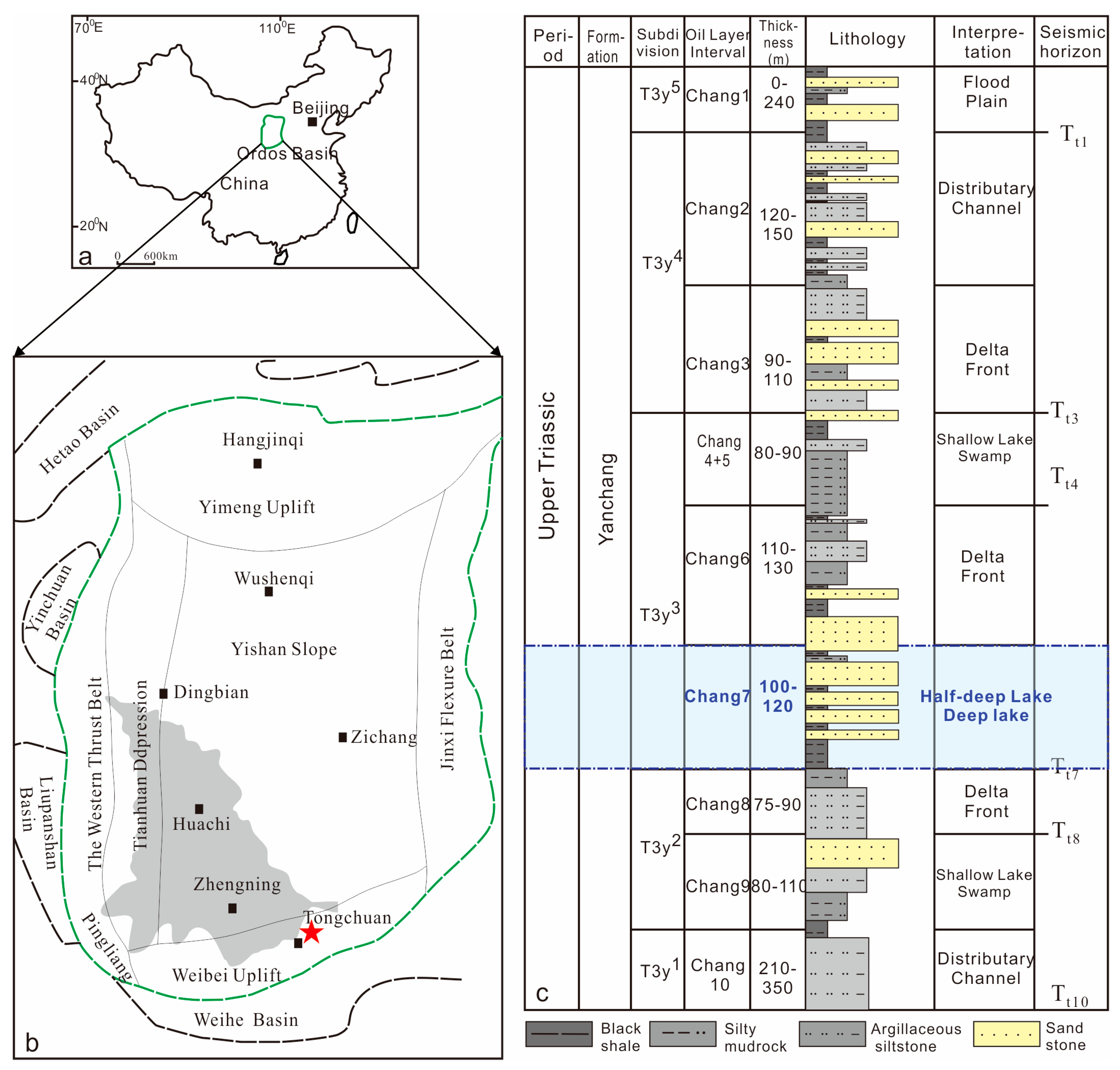
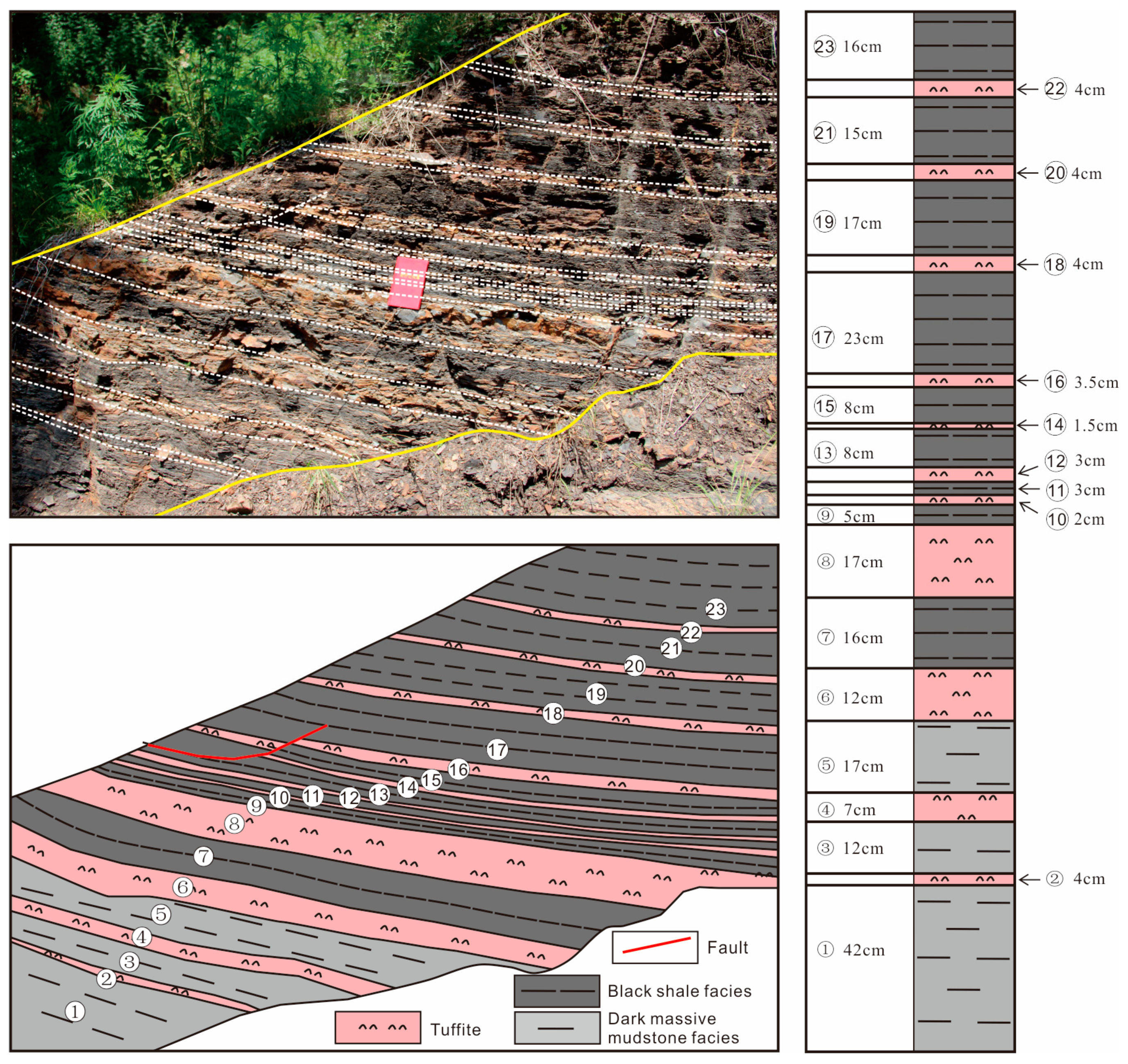

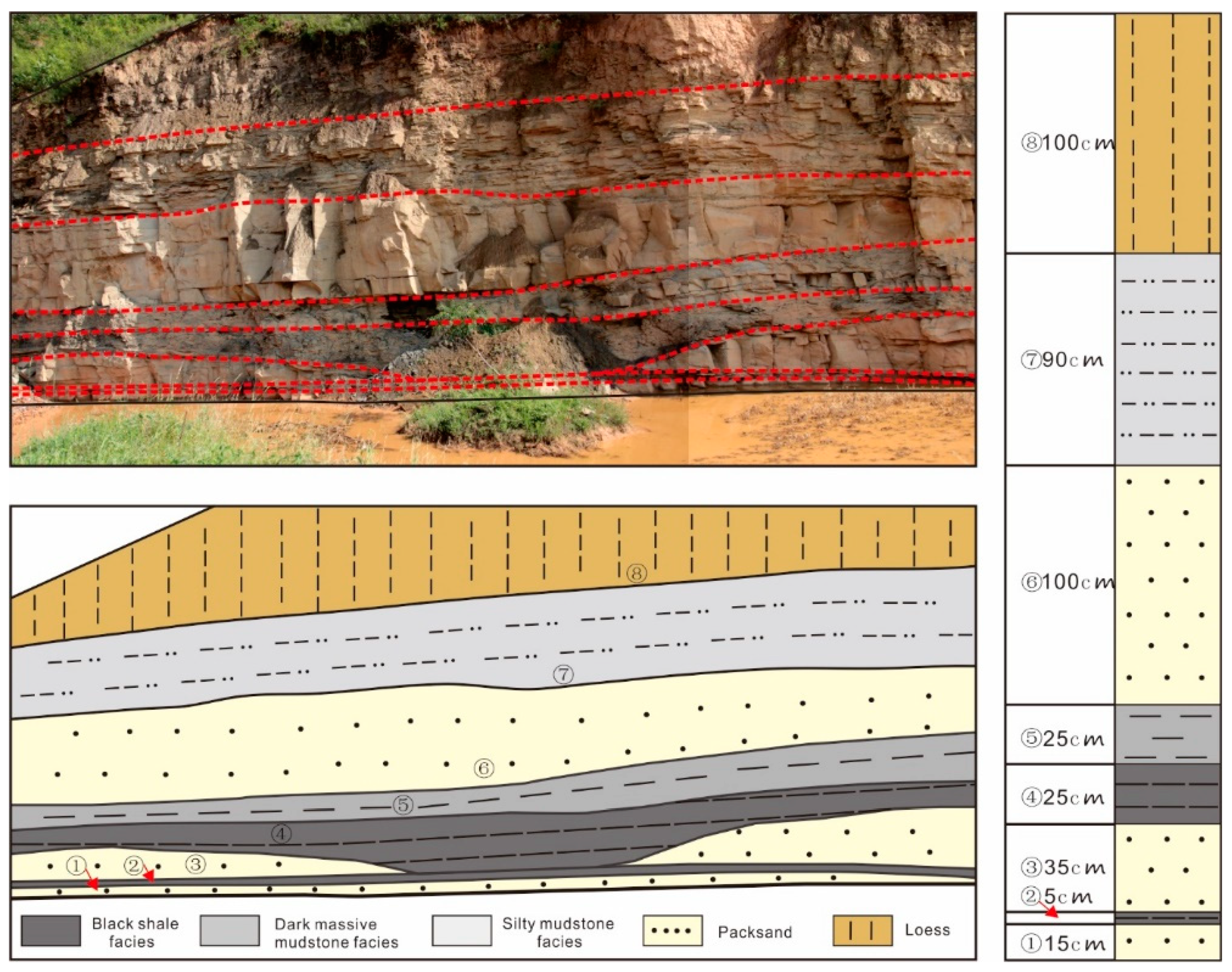
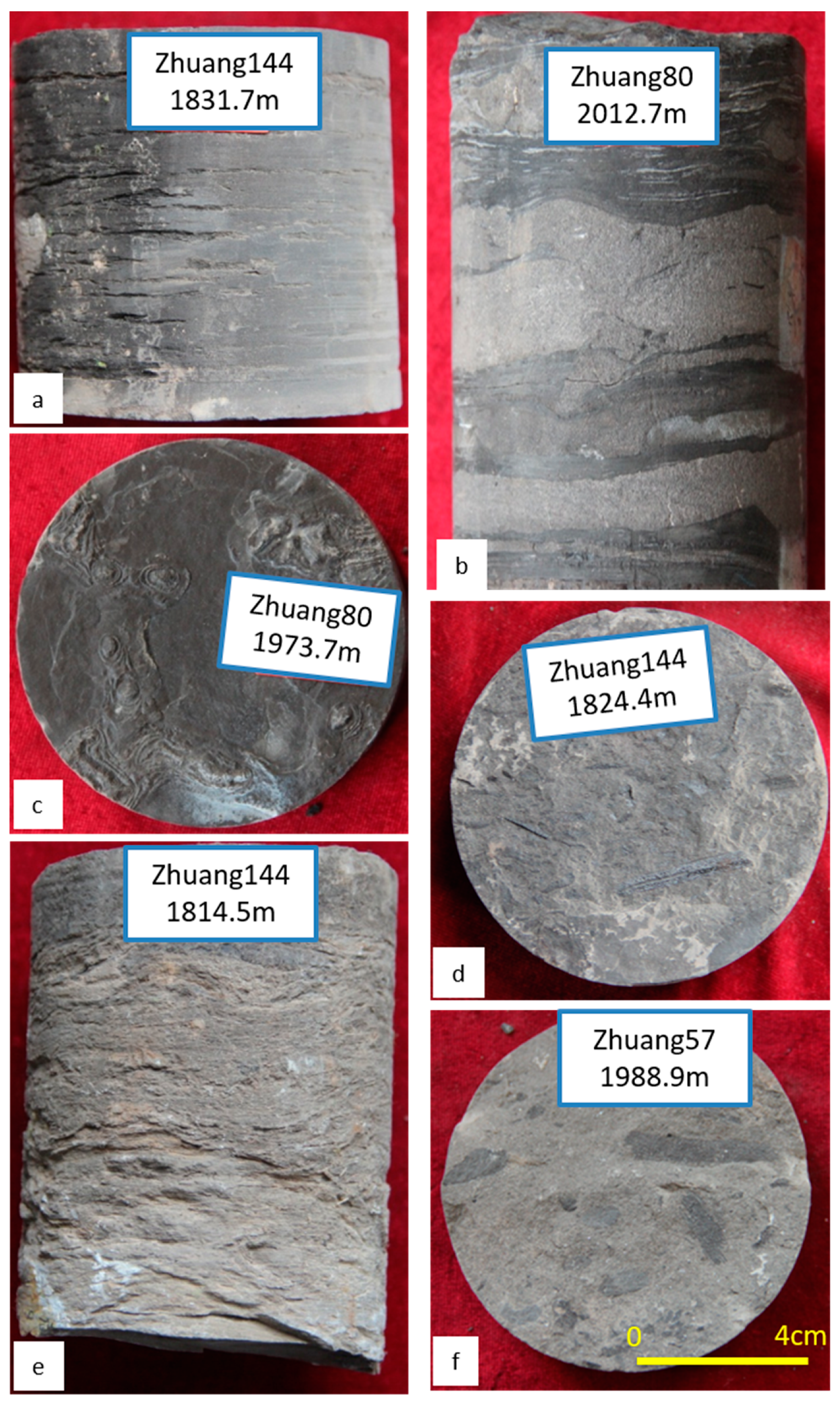
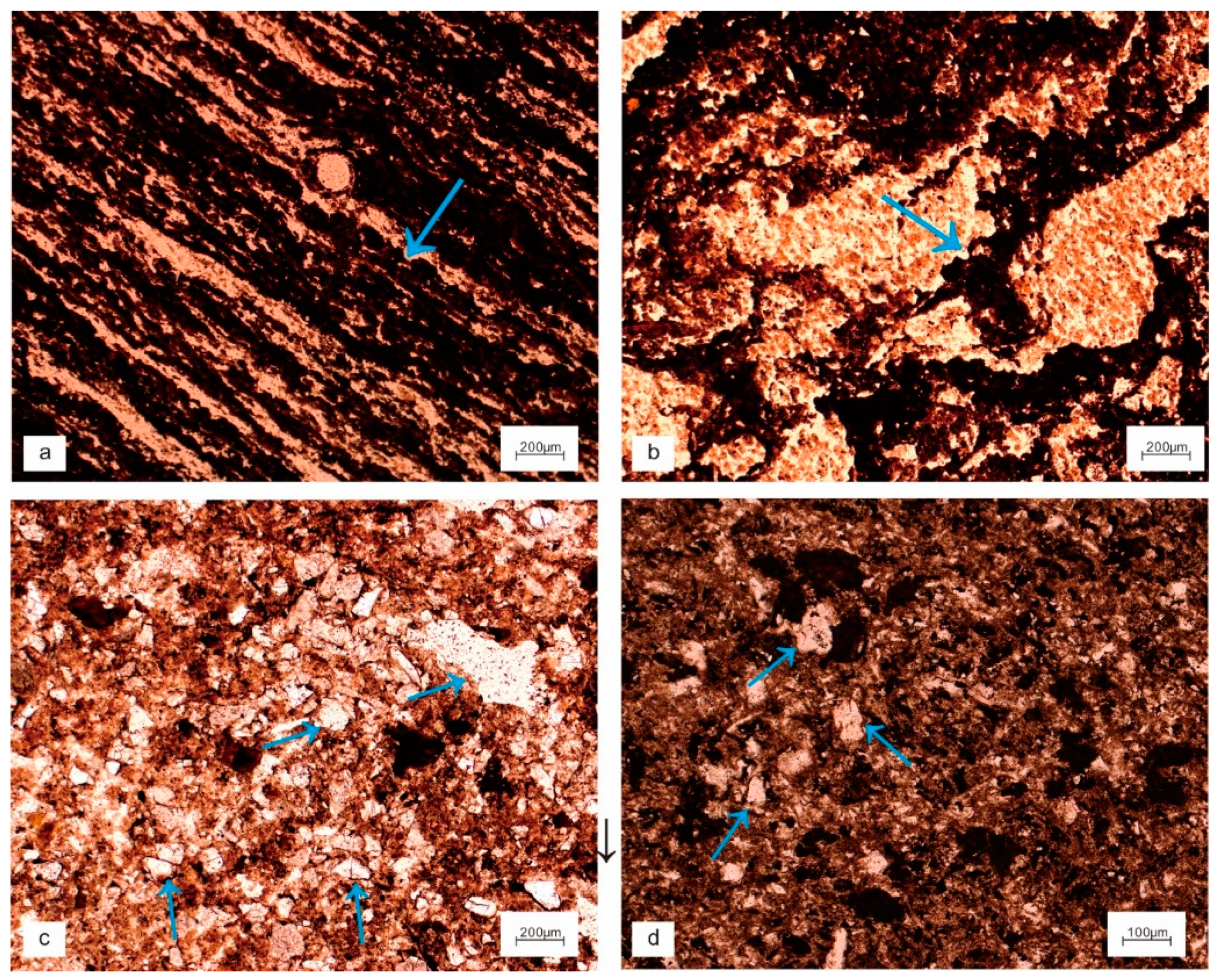


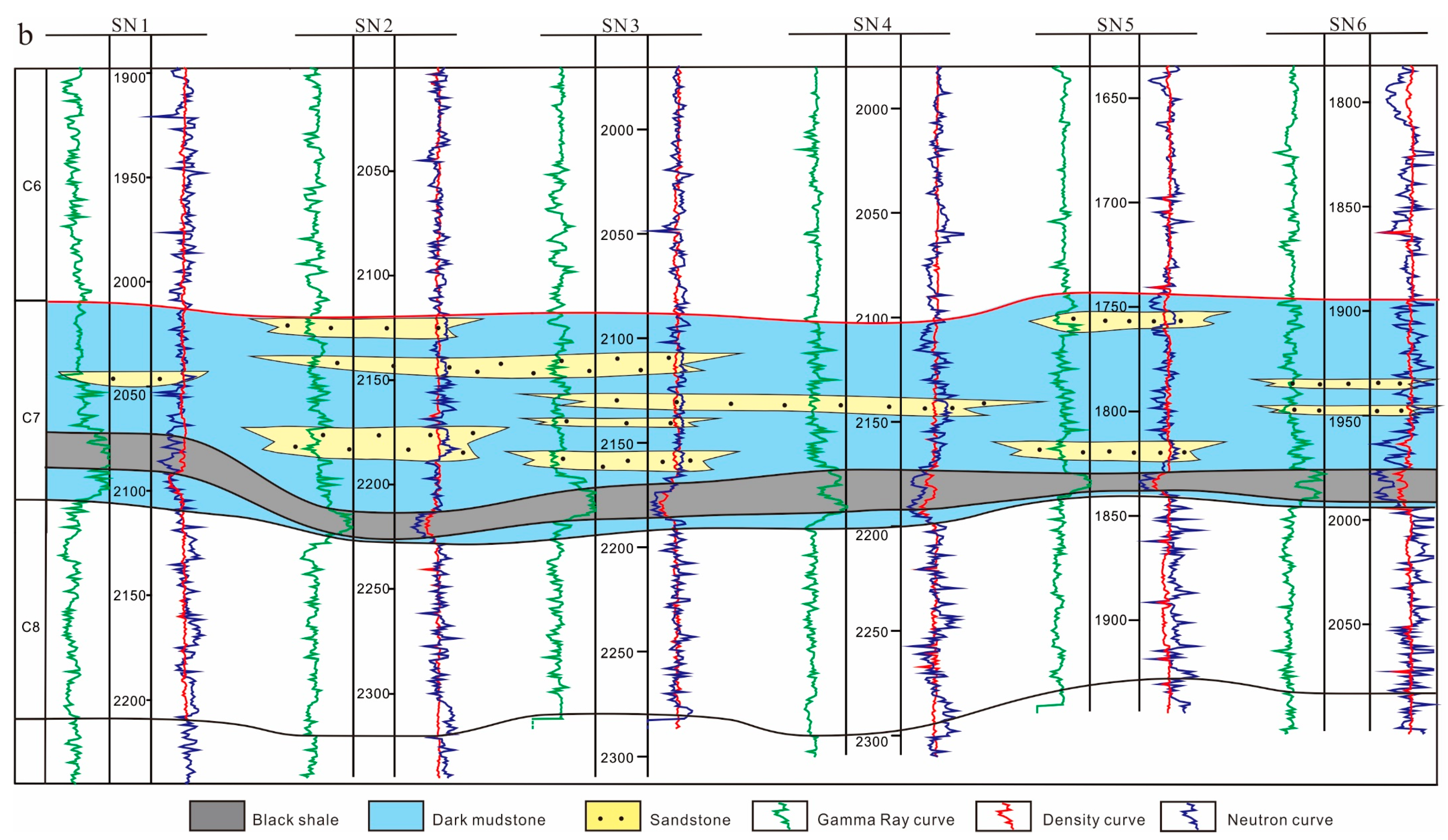
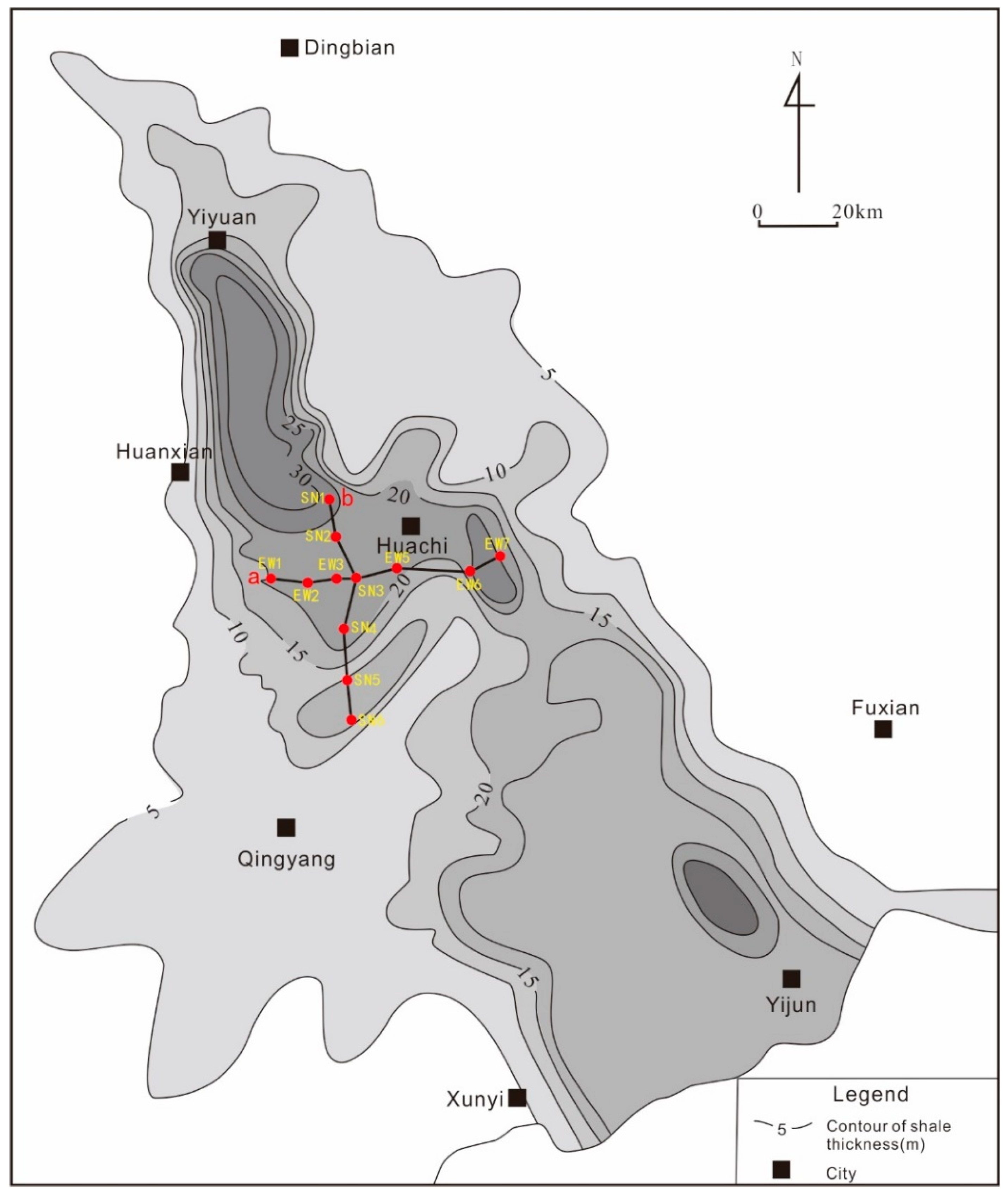
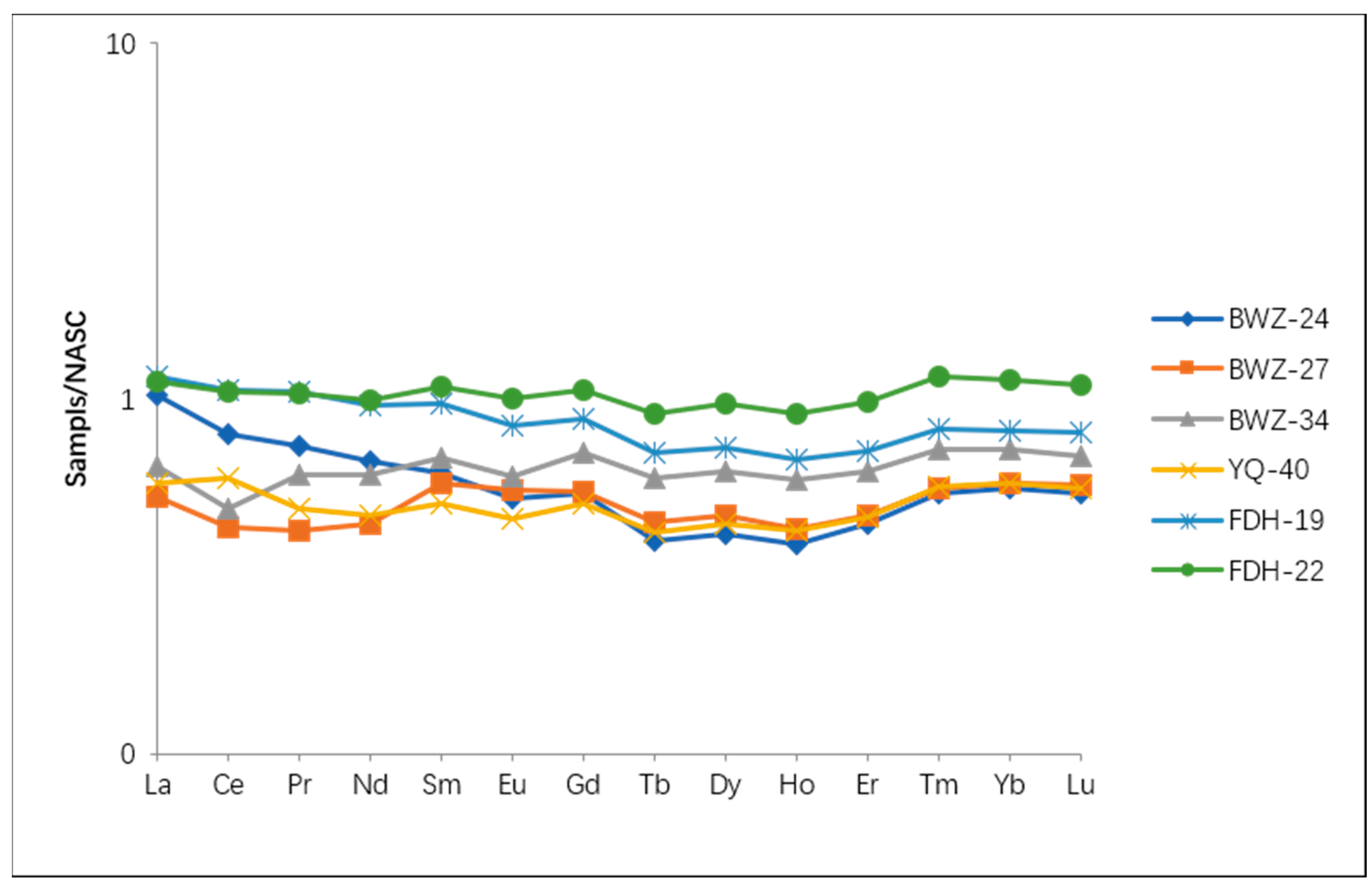
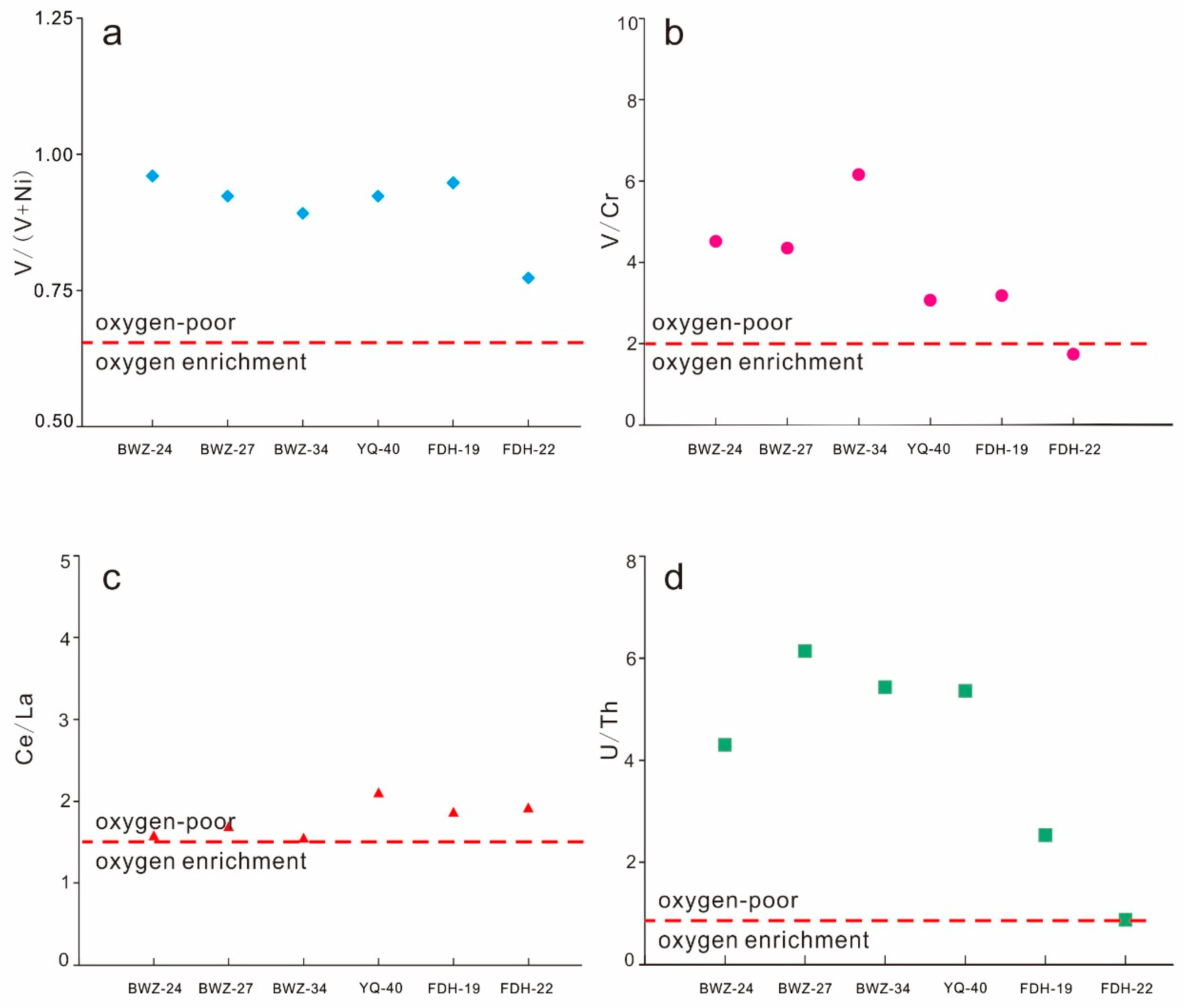

| Samples | SiO2 | TiO2 | Al2O3 | Fe2O3 | MnO | MgO | CaO | Na2O | K2O | P2O5 |
|---|---|---|---|---|---|---|---|---|---|---|
| BWZ-24 | 40.15 | 0.48 | 6.57 | 11.50 | <0.01 | 0.34 | 0.10 | 0.51 | 2.17 | 0.31 |
| BWZ-27 | 37.08 | 0.52 | 11.22 | 5.07 | 0.02 | 0.58 | 0.46 | 0.75 | 2.37 | 0.26 |
| BWZ-34 | 38.46 | 0.30 | 10.17 | 8.02 | 0.02 | 0.56 | 0.66 | 0.58 | 1.72 | 0.26 |
| YQ-40 | 34.62 | 0.55 | 12.39 | 9.02 | 0.02 | 0.58 | 0.68 | 1.04 | 2.96 | 0.22 |
| FDH-19 | 46.12 | 0.52 | 14.35 | 5.10 | 0.01 | 0.85 | 0.72 | 1.12 | 2.63 | 0.42 |
| FDH-22 | 50.78 | 0.56 | 16.67 | 5.67 | 0.08 | 1.72 | 0.76 | 1.12 | 2.91 | 0.25 |
| average | 41.20 | 0.49 | 11.90 | 7.40 | 0.03 | 0.77 | 0.56 | 0.85 | 2.46 | 0.29 |
| North American shale | 15.40 | 4.02 | 3.11 | 0.65 | 3.24 | 2.44 | 0.12 | 1.30 |
| Samples | BWZ-24 | BWZ-27 | BWZ-34 | YQ-40 | FDH-19 | FDH-22 |
|---|---|---|---|---|---|---|
| Hf | 2.69 | 2.93 | 2.89 | 3.07 | 2.66 | 3.00 |
| Ta | 0.53 | 0.60 | 0.65 | 0.62 | 0.79 | 0.87 |
| Pb | 23.0 | 23.2 | 26.9 | 30.1 | 40.2 | 39.2 |
| Th | 9.23 | 5.91 | 7.34 | 6.22 | 12.8 | 13.9 |
| U | 39.7 | 36.3 | 39.8 | 33.3 | 32.3 | 12.1 |
| Li | 17.0 | 22.3 | 25.0 | 31.5 | 30.0 | 45.4 |
| Be | 1.06 | 2.08 | 1.91 | 2.22 | 2.46 | 2.74 |
| Sc | 10.4 | 6.77 | 5.53 | 9.49 | 11.3 | 15.0 |
| V | 166 | 224 | 223 | 214 | 212 | 127 |
| Cr | 36.8 | 51.4 | 36.2 | 69.7 | 66.6 | 73.1 |
| Co | 14.9 | 6.83 | 20.6 | 12.8 | 5.25 | 28.8 |
| Ni | 6.97 | 18.7 | 27.2 | 18.0 | 11.8 | 37.5 |
| Cu | 103 | 133 | 122 | 124 | 110 | 71.3 |
| Zn | 8.38 | 12.4 | 48.8 | 23.7 | 23.1 | 101 |
| Ga | 14.3 | 17.2 | 13.7 | 17.5 | 21.7 | 22.5 |
| Ge | 1.46 | 1.63 | 1.18 | 1.47 | 1.62 | 1.52 |
| Rb | 116 | 76.3 | 76.1 | 104 | 148 | 159 |
| Sr | 108 | 62.7 | 90.1 | 105 | 366 | 143 |
| Y | 8.63 | 7.81 | 13.6 | 9.03 | 14.8 | 21.2 |
| Zr | 100 | 102 | 96.6 | 103 | 92.7 | 103 |
| Nb | 7.35 | 8.52 | 7.84 | 8.28 | 10.1 | 11.0 |
| Cs | 6.10 | 9.50 | 7.56 | 8.74 | 11.9 | 16.5 |
| Ba | 601 | 428 | 432 | 339 | 491 | 504 |
| La | 31.69 | 16.41 | 20.08 | 17.98 | 35.70 | 34.47 |
| Ce | 49.98 | 27.46 | 30.76 | 37.53 | 66.83 | 65.59 |
| Pr | 5.20 | 3.02 | 4.33 | 3.47 | 7.41 | 7.31 |
| Nd | 18.00 | 11.93 | 16.57 | 12.65 | 25.96 | 26.70 |
| Sm | 2.89 | 2.73 | 3.19 | 2.37 | 4.54 | 5.07 |
| Eu | 0.52 | 0.55 | 0.61 | 0.46 | 0.84 | 1.00 |
| Gd | 2.16 | 2.20 | 2.83 | 2.03 | 3.52 | 4.23 |
| Tb | 0.28 | 0.32 | 0.42 | 0.29 | 0.49 | 0.63 |
| Dy | 1.62 | 1.82 | 2.45 | 1.74 | 2.85 | 3.76 |
| Ho | 0.32 | 0.36 | 0.49 | 0.35 | 0.56 | 0.76 |
| Er | 1.02 | 1.07 | 1.44 | 1.06 | 1.64 | 2.24 |
| Tm | 0.16 | 0.17 | 0.22 | 0.17 | 0.25 | 0.35 |
| Yb | 1.12 | 1.15 | 1.43 | 1.15 | 1.63 | 2.26 |
| Lu | 0.17 | 0.18 | 0.21 | 0.17 | 0.25 | 0.34 |
| ∑REE | 115.13 | 69.36 | 85.01 | 81.44 | 152.47 | 154.71 |
| LREE | 108.29 | 62.10 | 75.53 | 74.47 | 141.27 | 140.14 |
| HREE | 6.84 | 7.26 | 9.49 | 6.97 | 11.20 | 14.56 |
| LREE/HREE | 15.82 | 8.55 | 7.96 | 10.68 | 12.62 | 9.62 |
| Redox Condition | Paleo-Oxygenation Facies | U/Th | V/(V + Ni) | V/Cr | Ni/Co | Ce/La |
|---|---|---|---|---|---|---|
| Reduction | Anaerobism | >1.25 | 0.84–0.89 | >4.25 | >7 | >2 |
| Weak reduction | Extremely oxygen-poor | 0.6–0.84 | 1.8–2 | |||
| Weak oxidation | Oxygen-poor | 0.75–1.25 | 0.46–0.6 | 2–4.25 | 5–7 | 1.5–1.8 |
| Oxidation | Oxygen-rich | <0.75 | <0.46 | <2 | <5 | <1.5 |
Disclaimer/Publisher’s Note: The statements, opinions and data contained in all publications are solely those of the individual author(s) and contributor(s) and not of MDPI and/or the editor(s). MDPI and/or the editor(s) disclaim responsibility for any injury to people or property resulting from any ideas, methods, instructions or products referred to in the content. |
© 2023 by the authors. Licensee MDPI, Basel, Switzerland. This article is an open access article distributed under the terms and conditions of the Creative Commons Attribution (CC BY) license (https://creativecommons.org/licenses/by/4.0/).
Share and Cite
Sun, M.; Feng, C.; Li, Y. Characteristics and Paleoenvironment of High-Quality Shale in the Triassic Yanchang Formation, Southern Margin of the Ordos Basin. Minerals 2023, 13, 1075. https://doi.org/10.3390/min13081075
Sun M, Feng C, Li Y. Characteristics and Paleoenvironment of High-Quality Shale in the Triassic Yanchang Formation, Southern Margin of the Ordos Basin. Minerals. 2023; 13(8):1075. https://doi.org/10.3390/min13081075
Chicago/Turabian StyleSun, Mengsi, Congjun Feng, and Yipu Li. 2023. "Characteristics and Paleoenvironment of High-Quality Shale in the Triassic Yanchang Formation, Southern Margin of the Ordos Basin" Minerals 13, no. 8: 1075. https://doi.org/10.3390/min13081075




